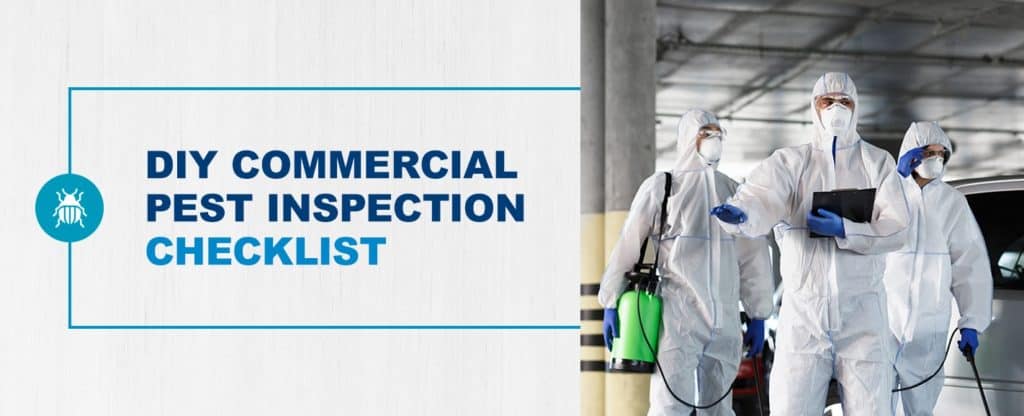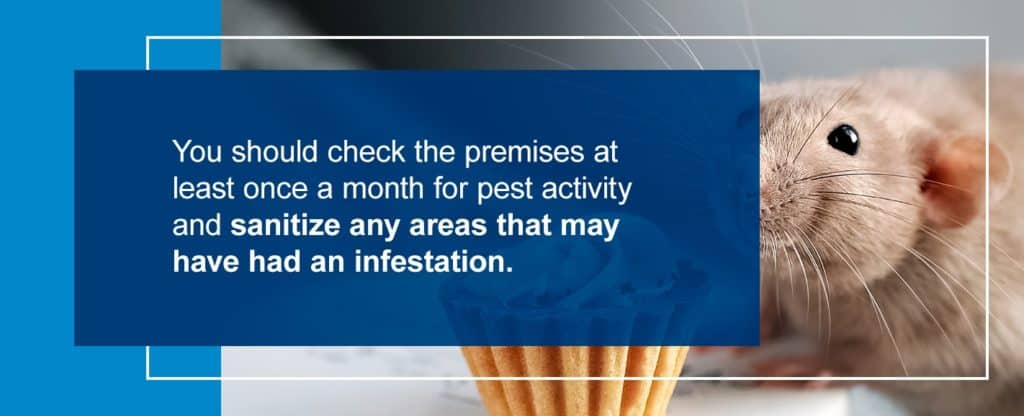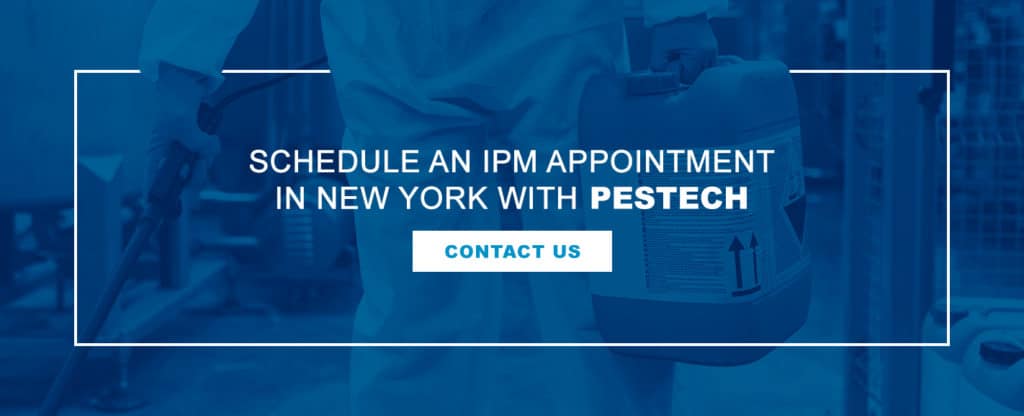DIY Commercial Pest Inspection Checklist

If you own a business, integrated pest management (IPM) services can help you eliminate pest activity to maintain the integrity of your company and protect the health of your employees and customers.
Even if you have an IPM program in place with a pest control company, you should inspect and clean your facility seasonally between your appointments to keep your business safe from pests.
Use this free commercial pest inspection checklist to inspect and help prevent rodents, wildlife and insects from sneaking into your business.
Download Commercial Pest Inspection Checklist/a>
How to Spot Pest Activity
The most common types of pests to infest commercial areas are rodents and insects, especially cockroaches.
Rodent Activity
Look for the signs of rodent activity in your company’s building.
- Rodent droppings on countertops or the floor, particularly near areas with food or moisture.
- Greasy marks on cabinets or walls from mouse or rat hair.
- Movement, gnawing or squeaking sounds in ceilings, walls and cupboards.
- Debris from cardboard, rags, straw or paper that rodents could use to make nests.
- Gnawing marks on food containers, wood, conduits, soap, soft metals or cables.
Insect Activity
Check your facility for signs of an insect infestation, including:
- Insects in the sticky traps you’ve placed throughout the property.
- Evidence of debris or damage that may have come from insects.
- Body parts of insects, such as a shed exoskeleton or wings.
Cockroach Activity
Inspect the interior of your commercial building for the following signs of cockroach activity:
- A musty smell that could result in allergy symptoms.
- Droppings that look like small spindles or specks of pepper.
- Remains of dead cockroaches, including in traps.
Download Commercial Pest Inspection Checklist

Preventative Pest Control for Businesses
To keep pests away from your business, you should reduce their ability to enter through the exterior walls. Follow these tips for dealing with the particular pests that could infest your property. You should check the premises at least once a month for pest activity and sanitize any areas that may have had an infestation.
How to Prevent:
Download Commercial Pest Inspection Checklist/a>
How to Prevent Rodents
Here are some ways to prevent rodents, including mice, rats and raccoons, from infesting your commercial facility.
- Sweep debris where you store and prepare food.
- Seal foodstuffs in covered containers on shelves instead of the floor.
- Seal doors, windows and other openings so rodents can’t squeeze inside.
- Remove clutter, such as boxes and paper.
- Cover trash containers, sealing them securely.
How to Prevent Cockroaches
Follow these tips for keeping cockroaches from coming into your institution.
- Inspect your commercial property with a flashlight for places where cockroaches could build a nest.
- Vacuum at least once a week to remove crumbs that could attract cockroaches.
- Seal any gaps or holes in the walls, doors or windows to limit areas where they could hide.
- Remove clutter to take away possible nesting places.
- Disinfect surfaces and equipment that may have had an infestation already.
- Dispose of dead cockroaches and disinfect the area.
- Place baits where you discovered any cockroach activity.
- Replace traps that have previously captured these insects.
- Check the premises at least once a month for pest activity.
How to Prevent Insects
Prevent an infestation of insects, including termites, flies and mosquitoes by practicing these habits regularly.
- Reduce standing water around your property.
- Inspect mattresses and upholstered furniture for bed bugs.
- Inspect your pipes for leaks, and repair rotten wood.
- Dispose of water outside the building, and make sure you have a proper irrigation system.
- Get rid of vegetation or mulch placed against or near the building.
- Limit the use of lighting near the building that could attract moths and flies.
Preventative Measures by Industry
If you’re the owner or manager of a company, here are some specific tips for keeping pests out of your facility based on the industry.
Jump to:
- Restaurants
- Hotels
- Apartments / Property Managers
- Distribution & Warehouses
- Food Handling Facilities
- Health Care Centers
- Schools
- Retail Businesses
Restaurants
Here are ways to prevent pests in your restaurant:
- Look for overgrown trees or shrubbery and cut them back so they don’t touch the building.
- Check for significant gaps or cracks in the building’s exterior and recaulk as necessary.
- Ask employees to clean the food out of their desks, lockers and other personal storage units and look for pest damage.
- Inspect the drains for any pest activity and refill P-traps in the floor drains.
- Empty all trash cans outside at the end of each day.
- Arrange for garbage pickup and bag and seal any contents that you dispose of before garbage day.
- Repair any leaks you notice in the plumbing in kitchens or bathrooms.
- Turn the lights off in the kitchen and break areas and look for pest activity with a flashlight.
- Fix any air conditioning units on the roof producing too much condensation and dripping onto your property.
- Replace the screens of your ventilation systems if they have holes or gaps where pests could enter the building.
- Close exterior doors when not in use, or use screened doors to provide proper ventilation for hot kitchens.
- Repair damaged tiles and grout in the kitchen.
- Clean soda machines often and wipe up spills immediately to prevent stains.
- Practice first-in, first-out rotation when serving and preparing food.
Hotels
Keep the pests out of your hotel by following these tips:
- Cut back foliage and low-hanging branches at least 2 feet from the building.
- Plant greenery that repels pests.
- Repair your HVAC system so air flows out of open doors and blows out pests.
- Keep doors shut when you can, and set up door sweeps and seal gaps.
- Use artificial plants inside the building as decoration instead of real ones.
- Limit outside water sources, such as sprinklers, around door areas.
- Ask housekeeping staff to check potential pest hiding places and report any activity to maintenance.
- Get rid of debris and excess moisture wherever possible while cleaning the guest rooms.
- Inspect all incoming shipments for cockroaches, flies, stored-product pests and rodents.
- Seal areas behind appliances and furniture.
- Clean under vending machines and ice machines.
- Clean the area near trash cans, removing wrappers and spills as soon as you notice them.
- Repair leaks from beverage and ice machines.
- Mop floors regularly and get rid of residue that could attract pests.
- Line all the trash cans and keep them tightly covered.
- Only allow food or drink items in designated areas.
- Get rid of standing water from rainstorms on or near the property.
- Dispose of lint and other debris in the laundry room to prevent mold growth.
- Remove the floor drain covers and clean drains once a month by wiping them with a brush and detergent.
- Regularly deep clean the loading dock and surrounding pavement.
- Set up bird repellents on the ledges and prevent nesting areas on the roof.
- Remove empty boxes and other waste from the loading dock.
- Keep doors closed around the loading dock when not in use and think about setting up a double-door system.
- Seal openings on the loading dock with mesh wire and a weather-resistant sealant.
- Sanitize trash cans and garbage dumpsters frequently.
- Move dumpsters away from the side of the building.
- Rotate dumpsters regularly so you can clean them more effectively.
- Remove discarded food and trash away from the area surrounding the dumpsters.
Apartment Complexes
Here are some tips for dealing with pests for property managers:
- During maintenance appointments, ask the technicians to look in problem areas where rodents, cockroaches, flies, ants and bed bugs can hide.
- Fix broken windows, screens, vent covers or holes in exterior walls immediately.
- Use automatic door closers on doors that tend to be left open.
- Fix windows and doors that don’t close as soon as possible.
- Avoid leaving the doors to kitchen areas or dumpsters open.
- Place screens over the air intake and exhaust vents.
- Check the integrity of your HVAC components to reduce excess moisture.
- Plug gaps and openings where wires and conduits come through the various parts of your residential property.
- Eliminate pest access in plumbing systems by repairing leaks and sealing gaps.
- Keep roof drains and downspouts open and unclog gutters.
- Replace rotted wood that could attract termites immediately.
- Insulate pipes that might be prone to condensation.
- Empty mop buckets and store mops head up to reduce standing water that attracts mosquitoes.
- Wash recyclable containers and trash receptacles regularly.
- Use metal trash bins that rodents can’t chew instead of plastic containers.
- Put garbage bags and tight-fitting lids on your bins for food and beverage waste and clean them weekly.
- Arrange for recyclables to be picked up at least once a week.
- Store dumpsters and trash cans away from the building on asphalt or concrete surfaces.
- Make sure you have enough trash receptacles and dumpsters for the amount of trash you dispose of.
- Encourage your residents and staff to report any rodent or insect activity.
Distribution Centers and Warehouses
Follow these steps for preventing and getting rid of the pests in your distribution center or warehouse:
- Get rid of gaps, cracks and holes where pests could sneak in.
- Have your employees keep track of any pest activity they notice.
- Clean floor drains to ensure proper moisture control.
- Take out the garbage every day, and scrub out your garbage bins regularly.
- Cover dumpsters when you’re not using them.
- Store dumpsters away from the entrances and exits.
- Use garbage bags instead of throwing garbage directly into the bin.
Food Handling Facilities
You can keep pests away from your food handling facility by following these tips:
- Train your employees to recognize pest activity signs, and give them a place to report if they see any.
- Teach your janitorial staff to clean appropriately to prevent activity from pests.
- Have a daily, weekly and monthly maintenance checklist for taking care of the facilities.
- Weatherstrip the gaps underneath the openings of your doors, or install door sweeps.
- Instead of propping doors open, make sure you have enough ventilation for hot days or places where you cook.
- Seal the gaps around piping, cabling or other penetrations into the structure.
- Fill in structural cracks or holes larger than a quarter inch.
- Trim the vegetation that’s too close to the building so insects don’t have easy access.
- Get rid of standing water anywhere near the outside of your commercial property, including on your roof.
- Repair any missing or damaged screens covering the ventilation or exhaust fans.
- Clear or repair blocked or damaged gutter downspouts.
- Inspect all packages that come through the facility for stored-product insects.
- Conduct inspections at least once a month to make sure you don’t have evidence of pest activity.
- Deep clean food storage areas at least once a month, depending on your inventory.
Health Care Centers
Get rid of pests in your health care facility with these steps:
- Find and remove sources of moisture, such as clogged drains and leaky pipes.
- Seal and store food properly, especially in cafeterias and kitchens.
- Regularly clean high-volume areas like break rooms and cafeterias, where crumbs and other residues could accumulate.
- Dispose of garbage in sealed cans or dumpsters.
- Inspect delivery boxes before storing them in the kitchen or pharmaceutical shelves.
- Make sure there’s proper ventilation in storage areas.
- Seal cracks and holes on the outside of the building.
- Repair and dispose of decaying wood around the facility.
- Replace worn weatherstripping around doors and windows.
- Trim or remove any vegetation and keep shrubbery a few feet away from the building.
- Regularly check for any kitchen drain clogs or leaks in refrigerators.
- Close entryways from loading docks instead of propping them open.
Schools
Here’s how to prevent and get rid of pests in your educational institution:
- Restrict where students and faculty are allowed to eat.
- Dispose of garbage daily in sealed garbage containers.
- Move dumpsters and disposal containers away from the building.
- Repair and maintain leaking pipes.
- Regularly clean cafeterias and break rooms where pest activity is most common.
- Seal the cracks and crevices throughout the exterior wall of the building.
- Sanitize the facility often, primarily in those areas where you’ve discovered pest activity.
- Clean the gutters and direct water away from the premises to prevent water accumulation.
- Teach students and staff about how their actions affect pest management and control.
Retail Businesses
Follow these tips for eliminating pest activity in your retail facility or commercial building:
- Keep food in transparent, air-tight containers.
- Store clothing in plastic wrap to prevent insects from damaging merchandise.
- Place containers on a shelf off the ground to prevent rodents from entering them.
- Have plenty of storage to reduce clutter and keep inventory organized.
- Keep non-perishable food items away from housewares and other things.
- Get rid of excess cardboard where rodents and other pests could hide.
- Keep trash receptacles away from the shelves to prevent cross-contamination.
- Carefully inspect drywall areas for holes and cracks, and seal them as necessary.
- Install door sweeps to make sure that sliding doors meet and seal.
- Change out weather stripping on roll-up doors.
- Sweep and mop floors at least once a week, depending on foot traffic.
- Empty garbage several times a day, leaving it empty overnight.
- Keep dumpster area clean, and have dumpsters serviced regularly.
Schedule an IPM Appointment in New York With Pestech

At Pestech, we offer commercial IPM for all types of commercial facilities in New York. We inspect the most common entry points where pests enter buildings so that your business can have protection.
Contact us to schedule an inspection with us to set up an IPM schedule for your business.
